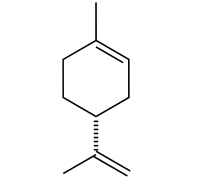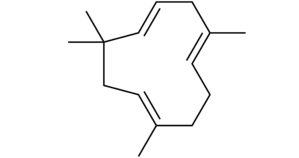Research and a Better Understanding of the Medicinal Properties of Cannabis Terpenes
Recent advancements may make terpenes ripe for pharmaceutical development and other important applications.
Most people familiar with the cannabis field are aware of the chemical compounds called terpenes. Those in the food industry are likely knowledgeable about terpenes as well. These small organic chemicals are present in varying amounts in many plants, spices, and other food sources. In nature, terpenes function as either attractants to pollenating insects or deterrents to pests or predators. Research has shown that terpenes are associated with medicinal effects in humans as well. Despite the wide-ranging significance of terpenes, isolation and pharmacological use of these compounds has been limited until this point. Recent research advancements, however, may change the course of such work, making terpenes ripe for pharmaceutical development and other important applications.

For a refresher and for those new to the field, terpenes are complex, aromatic compounds that give cannabis and other plants the distinct aromas and contribute to the flavor profile of different plant types. For example, Limonene (shown right top) is a cyclic monoterpene responsible for the lemon scent attributed to citrus fruit. Whereas, Humulene (shown right bottom) is a monocyclic sesquiterpene with a distinct pine scent principally found as an aromatic component in hops.
Cannabis contains hundreds of unique phytochemicals, and terpenes form the major class of these compounds. Medicinal properties of terpenes include analgesic, anti-inflammatory, and a range of other effects, and ongoing research is aiming to validate and expand these attributes. Another important and curious role played by terpenes is the so-called entourage effect, where these compounds complement cannabinoids and other chemicals in eliciting synergistic effects on cannabinoid receptors thereby producing enhanced physiological effects on the body.
 There are significant challenges with terpenes isolation,
and cannabis testing for that matter, that relate to the chemical properties
and diversity of the compounds. The vapor pressures, hydrophobicity, thermal
sensitivity, and the reluctance to efficiently ionize for analysis by gas or
liquid chromatography make detection and quantitative measurement difficult.
Moreover, terpenes are present in very low abundance in natural sources
including cannabis making their practical use limited. Although progress has
been made to characterize terpene genes and their genomic arrangement in
plants, there has been a lack of methods to overexpress and isolate terpenes until
this point. As a result, terpenes remain a potentially important yet untapped
area of research and medicine.
There are significant challenges with terpenes isolation,
and cannabis testing for that matter, that relate to the chemical properties
and diversity of the compounds. The vapor pressures, hydrophobicity, thermal
sensitivity, and the reluctance to efficiently ionize for analysis by gas or
liquid chromatography make detection and quantitative measurement difficult.
Moreover, terpenes are present in very low abundance in natural sources
including cannabis making their practical use limited. Although progress has
been made to characterize terpene genes and their genomic arrangement in
plants, there has been a lack of methods to overexpress and isolate terpenes until
this point. As a result, terpenes remain a potentially important yet untapped
area of research and medicine.
In a set of peer-reviewed studies recently published in the journal Nature Chemical Biology, investigators identified and characterized a collection of gene clusters in soft corals that encode for terpenes synthesis. The work in these two reports titled Ancient defensive terpene biosynthetic gene clusters in the soft corals, and Ancient plant-like terpene biosynthesis in corals is significant on several levels.
Terpenes and terpene-derived compounds from marine sources have proven valuable in research and biomedical applications. A problem is the limited supply and availability of methods to capture these from natural sources. Although terpenes have been found to function as major defensive small molecules that contribute to soft coral survival, their origin has remained a mystery. Most small molecules in marine environments, including those for defense, are synthesized by symbiotic microbes, rather than by the host itself.
As opposed to bacteria and plants in which terpene genes have already been identified, this work demonstrates for the first time that animals also harbor defensive terpene genes. Terpene cyclase genes were identified as forming clusters on a single chromosome, pointing to the sharing of these clusters among many different coral species. Indeed, the investigators characterized 15 terpene cyclase enzymes from nine genera of organisms, many of which colocalized with enzyme-encoding genes known to modify terpenes into a large range of unique compounds.
What do these findings mean for biomedical and pharmaceutical applications? These terpene biosynthesis genes can be potentially cloned into recombinant expression systems such as E coli or Yeast. This may allow abundant and controlled production of terpenes in amounts that are amenable to both purification and use in various research and physiological contexts. Modification of these genes may allow the production of terpenes with specialized features such as reporter tags, fusions, and other elements, that will facilitate research investigations. Genetic engineering may eventually lead to terpenes with enhanced and specific pharmacological effects in the body.
What do these finding mean for cannabis research? Large-scale methods for terpene production may translate to methods for the production and isolation of cannabis-derived terpenes as well. Research may lead investigators to attribute distinct medicinal effects to a unique terpene compound or class of compounds. Further research may lead to advanced ways to control terpene production and methods to test for terpenes in cannabis as well.
Terpenes research, such as that described, is closing the gaps in our knowledge about these compounds and their importance in cannabis science and medicine.
Visit the LabX Cannabis Laboratory Application Page









